Death Valley is not nearby, and yet - it continues to call time after time, urging us to make the 20 hour journey south to explore its wonders. And it's hard to say no. That's how - on a Wednesday morning - we found ourselves packed up in the truck and heading towards southern California, excited for the three-and-a-half days we'd have to explore.
I promised myself that this trip would be different. We wouldn't attempt to squeeze everything in; I wouldn't over-schedule our time; it wouldn't be like it always is - a mad dash to not miss a thing. I'd do this by keeping us in the northwest corner of the park - in Eureka and Saline Valleys, and by planning at most a single morning and single afternoon "attraction."
Or so I thought.
By the end (literally, shortly after midnight) of our first full day of driving, we made it to Walker Lake. There are a couple of free BLM campgrounds along the edge of the lake, and though they are very close to the highway, @mrs.turbodb and I were both exhausted and decided that trying to make it two more hours to a spot we'd found outside of Dyer, NV to camp was just not in the cards. We climbed into the tent and within minutes we were both sound asleep.
Five hours later, at 5:30am, my alarm went off. Unlike most mornings, it wasn't set early to catch the sunrise, but was instead because we needed to get on the road if we were going to have time to do everything I'd planned for the day. (Yes, I realize now that this is perhaps not the approach that leads to a more relaxed trip.) Still, getting up early did have its benefits!
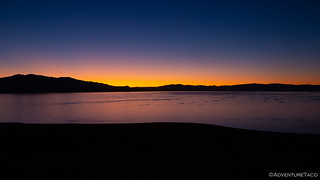
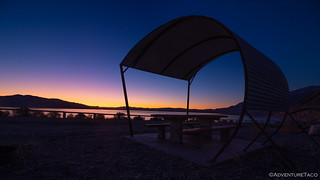
Intriguing sun shades provide relief to campers in the summer months.
By 9:00am, we'd fueled up in Dyer (Note: though the pumps appear closed before the store is open, hunt around and figure out how to use your credit card by lifting the rubber cover.) and were turning off onto dirt - our entrance into the park via North Eureka Valley Road, one that was new for @mrs.turbodb, and in my opinion the second nicest way into the park (because it's hard to beat Titus Canyon Rd.)



Under the warm morning sun we made good time, even with some photo stops for me, and geology stops for @mrs.turbodb, and it wasn't long before we reached the north end of Eureka Valley - the dunes where we'd be spending the night still just out of sight behind the north end of the Last Chance Range.
And they'd stay hidden a while longer, because our first destination was up in the mountains - to investigate the old sulfur mine and town site of Crater.

The Crater Mine - and its associated town - started operation in 1929 and produced 50,000 tons of pure sulfur by the time it closed down in 1969 (nearly 30% of all California's sulfur) and the area is still rich with the stinky stuff - some 3,000,000 tons of the stuff still left in the ground! (Hiking Western Death Valley)
As we pulled up to the mine site, the remnants of the last refinery were immediately visible in the middle of a barren playa. Over the course of mining here, twice there were sulfur dust explosions as the material was refined for transport. Most prominent were the crusher and retort, now laying like a lunar lander in the sulfur ore, its refractory bricks still lining the interior.



Wandering around, one could only wonder who kept passing gas as the sun's rays warmed the strikingly yellow ground around us, the light breeze only serving to waft the smell past our noses. 
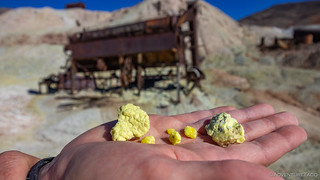
Most of the mines we find ourselves exploring are shaft-style mines, and Crater is one of the few pit mines that we've ever really walked around. The destruction of this style of mining was immediately apparent, the entire hillside having been carved out in search of quick profits.


Soon enough, we decided it was time to move on. Just up the hill was the old town site of the same name, all of its buildings reduced to piles of timber by the passing of time. Only three relics mark the town site today - some sort of old double-door cooler, a pair of water tanks, and a storage shed built into the hillside. In all honesty, probably not worth visiting if you want my opinion! 


Now, at this point, my plan had been that we'd eat lunch and then make our way back down into Eureka Valley so we could find a nice spot to camp and then make our way up the dunes. But @mrs.turbodb had gotten to reading Digonnet's Book, and well... there were several interesting things nearby that we decided we might as well add to the schedule.
So, after less than two hours in the park, our plan to keep things simple and not pack too much into a day went by the wayside. We were once again in full-on OMG there's so much to see mode.
Our first detour was to the El Captan Mine. This was an old Mercury mine, the 800-foot long shaft still completely open and easily large enough to drive a Tacoma into. Keen to stay alive, we refrained from such a foolish move - though curiosity did get the best of me and I walked in 50' or so - opting instead to drive up the hill through which the shaft passes to an enormous hole that was created at the other end.


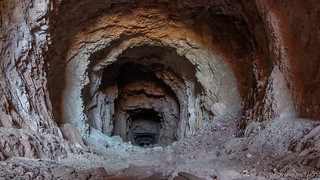
The hole was originally an access shaft that intersected the mine shaft 60-feet lower than its entrance, but when Mercury was found in the surrounding cinnabar ore, it became a glory hole - the material simply dropped down the hole to the end of the mine shaft where it could be hauled out. We kept ourselves out of this side of the mine altogether, its geological state clearly more precarious than the main shaft opening.

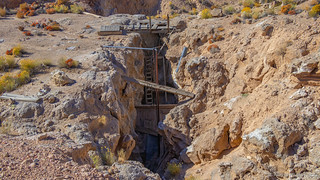

Our second mine explored, both of our stomachs were now audibly reminding us that our early morning departure meant that our first meal of the day was lunch - so we setup in the shade near the El Captan mine and devoured a couple of turkey sandwiches, potato chips, and a crispy cool apple before making our way back out towards Crater and something we'd missed our first time through.

See, in the early days of sulfur mining, rather than use the lunar-lander-looking retort to refine material, sulfur was melted - and concentrated - in large ovens. If you wonder - as we did - why would someone ever put an extremely flammable material into an oven? Well, I guess that's why there aren't many of these ovens still around. But one still exists in the area and we were going to check it out.


The oven was perhaps the coolest thing we'd seen so far, and the ground around it was pretty cool too. Even more so than the parts of Crater we'd already explored, it was peppered with crystallized, yellow rocks. Yep, you know it, fart rocks.

Well, the little yellow rocks did a great job of covering up any digestion issues we were having from lunch - not that I recall us having any - but it was time for us to move on... sort of. We still weren't headed down to the base of the Eureka Dunes, but instead were headed up to what would be the first of many spectacular valley views we'd experience on this trip.
It was as though - without even knowing it - we were, In Search of Overlooks.
At this one, we caught our first glimpse of the Eureka Dunes. At 680-feet tall, they are some of the tallest in North America - and yet in the distance and next to the Last Chance Range, they seemed anything but. It's yet another great reminder of how vast Death Valley really is!
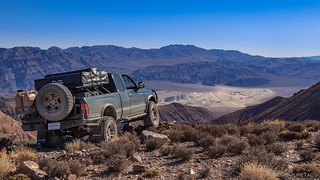
Our appetites now whet, we decided we'd leave the exploration of this overlook and its surrounding mines for another visit, and make our way to our previously planned destination: the dry camp at Eureka Dunes.
Cruising along Eureka Valley Road, all of our attention was in front of us - the brilliant dunes rising up out of the valley floor. Little did we know that behind us, the wing nut securing the fuel jerry cans was working its way loose, and would soon be lost to the desert, another victim of washboard roads. 

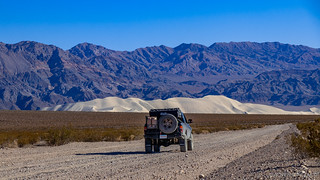
Luckily, this would turn out to be the only (known) casualty of the trip - and even so, one that didn't really affect us as the full cans were tightly wedged into the carrier on our CBI bumper, keeping them secure even at high speeds through the harsh terrain.
Before long we arrived at Eureka Dunes dry camp, happy to find ourselves alone on a Thursday night in the cluster of five or so sites. Picking one that we hoped would position us well for sunrise, I was excited. In my previous trips to Death Valley, I've always wanted to hike to the top of Eureka Dunes, but have never had the chance.
Today, that was going to change. Maybe. Because from down here, the dunes sure looked high. Add to that the fact that we were running on five hours of sleep, we were a couple hours behind schedule due to our well-honed squirrel-like attention spans earlier in the day, and the knowledge that the late fall sunset was a mere 2½ hours away... You can understand why we started talking about maybe just going up an intermediate dune to get some good photos.
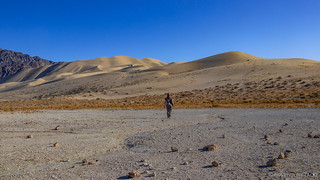
Hiking the dunes turned out to be like no other hike I've ever experienced. First of all, there's the sand - and hiking up mountains of the stuff - with slopes up to 45° in some places - is like walking up the down escalator... you swear your legs are moving, and yet you're not making any forward progress.
Add to that the sheer size of the dunes, and the struggle was real. And - while I must admit that we probably felt like this little beetle climbing the dunes - its struggle was more real than ours.
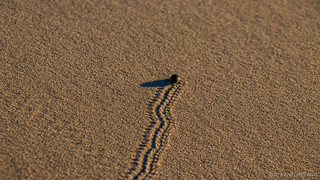
One foot in front of the other, some slipping and sliding, and eventually we made it to the top of our first ridge. The closest ridge to camp, it was clear that we weren't the first to make it here, footsteps transforming the sharp edge into a trail.

Even here, on this - the top of our first peak - the views were stunning. To our north, the colorful Last Chance Range towered above us, to the south, the dunes spilled over the valley floor another three miles into the distance.

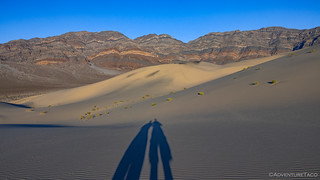
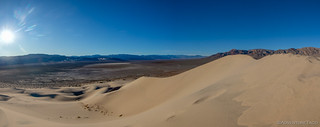
It was also here that @mrs.turbodb and I had a little "discussion" about what to do next. Despite our earlier conversation about staying at lower elevations, I was no longer sure that just exploring the dunes would be enough for me - I knew I'd regret not going to the top. Luckily for me, she decided to push through the tired legs and lack of sleep and we continued climbing.

Let me tell you something that is worth it: reaching the overlook atop Eureka Dunes. Here, with a little effort - OK, a lot of effort and some strategic planning of where to step in order to keep the dunes pristine - we found ourselves atop a clean crisp ridge, the sun just moments from dropping below the Saline Range to our south west. It was - if there ever was - a moment to celebrate!

Not 60 seconds after capturing our success, the dunes were cast into shadow and we knew it was time to get going. Surely it'd be faster than the trek up, but it was still nearly two miles back to the truck. With the moon already rising to the east, we started down.

The trip down was easier - but no less exhilarating - than the trip up. The best part - something everyone must experience for themselves - was the singing sand. As we'd walk down the dune, sand avalanching down the face of the dune would create friction, emitting an acoustic air wave that sounds like a distant airplane. It was truly spectacular.
And of course, the sky was putting on a show at the same time. As the colors above us transitioned from blue to purple over the course of our 40-minute descent, we couldn't have found ourselves in a more perfect spot.

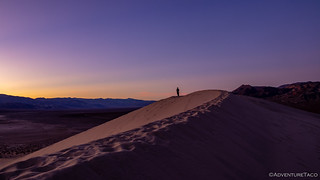
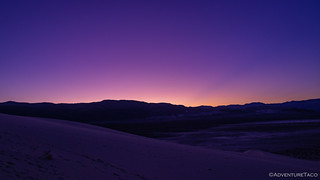
We arrived back at camp just a little after 5:00pm, night already starting to set in. Our first order of business - emptying our shoes and socks of the gallons of sand we'd picked up along the hike - was completed quickly, both of us hungry and looking forward to both dinner and bed.
While @mrs.turbodb got started on dinner - a chicken and asparagus risotto she'd mostly prepared at home, I set about deploying the tent and getting everything ready for us to crash for the night.
Dinner was delicious - its warmth welcome in the cold night air, the chicken and rice doing a good job of refueling us after our long day. It was just after 7:00pm when finished brushing our teeth and found ourselves climbing up the ladder into the tent to read our Kindles and drift off to sleep as the nearly-full moon illuminated the valley around us.

It had been a full day, and there was a lot more to come!
The Whole Story
Love Death Valley? Check out other trips!
![In Search of Overlooks - A Fall Trip to Western Death Valley [P1]](https://live.staticflickr.com/65535/49072602511_82aa16d541_h.jpg)
![Old Roads and Star Trails - In Search of Overlooks [2]](https://live.staticflickr.com/65535/49082756533_26e5373a5b_h.jpg)























Very nice writeup. Great pics.
Thanks Don. Hope you were able to read all for parts of the story! (Or at least see all the photos.)
Great photos of Eureka Dunes! I've been there three times, I think, and hoping to go again next month. How was the drive on North Eureka Valley Road from Dyer? I've never been that way but would like to try it sometime. I did exit Eureka Valley once via Willow Creek Road to NV-266, but that's the "other" road out of North Eureka Valley.
Two questions about the road from Dyer: Is it is graded and maintained road? and do you need 4WD?
So, these photos are from a while ago - a couple years - and I'm sure you know there was some significant flooding this year, so road conditions on the north end of Eureka Valley may have changed.
I've been out Willow Creek Rd as well (well, in that road, which I've known as Cucomungo Canyon Rd), and I'd say that overall the two are similar. There are portions of North Eureka Valley Road that are better than Willow/Cucomungo, and there are a couple portions where there are some significant washouts depending on the year. I've never needed 4WD.
You can see my attempt at Willow Creek/Cucomungo here: Snowy Roads, Dusty Roads, and a Small Tug - Hiking #1, which was part of my Hiking Saline Valley trip, where you can also see my ultimate entrance to the park on North Eureka Valley Road.
Oh, and there's actually a third unpaved road out the north end of Eureka Valley, which you can see at the tail end of that same trip. ?